Space-time functions are accessible from "Space-time" menu. (See Using Starlogin)
Planets rise and set hours
Select the planet the hours of
which you want to know, on the following dialog box, after having clicked on the
"Rises – Sets" button of the corresponding chart.
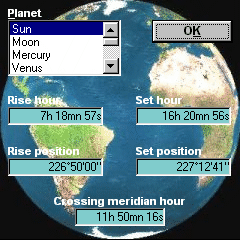
On the following window, you can see the
location of the event on the world map (Shown by a
curved cross), and the projected position of the planet. In addition, the equator (hizontal green dotted line), the Greenwich meridian (vertical green dotted line) and the ecliptic are shown. Finallly, you can also see the limit
between the nocturnal and the diurnal zones for the planet (orange widely curved line).
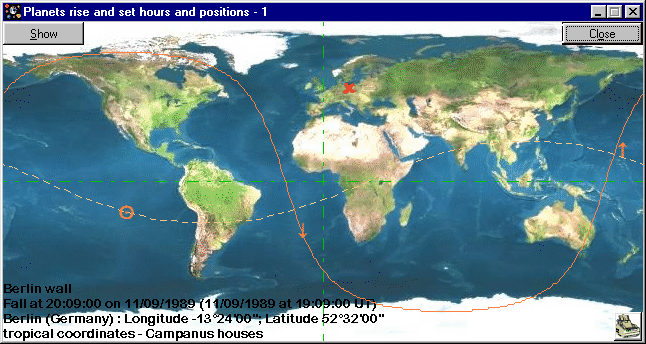
The arrow up indicates where the planet is currently rising (for
the date and hour of the chart). The other one indicates where it is setting. For the
countries between the two arrows, from right to left, the planet is not visible. On the above picture, the Sun is not visible in Africa, for example,
but it is about noon for Mexico and part of the US (California, e.g.). During a day, the Earth turns from west to east, so the planets seems to
turn from east to west (right to left on the chart) and the limit line and arrows move
with the planet.
Apparent angle and distances
between two planets
Apparent angle and distance between two planetsare calculated
from the "Distances" button of the chart.
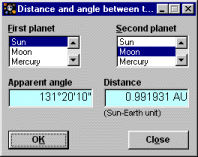
In the corresponding window, select the two planets the angle and
the distance of which you want to know, before validating.
Distance between two Earth
places
The angular and kilometric distances between two earth places are
calculated from "Distance between two places" submenu of "Space-time"
menu.
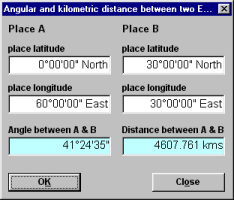
In the corresponding window, enter the coordinates (latitude
and longitude) for each place the distance between
which you want to know, before validating.
Alignments and angles between
three Earth places
The alignment and the angles between three earth places are
respectively calculated from "Alignment between three places" submenu of
"Space-time" menu and from "Angles between three places" one.
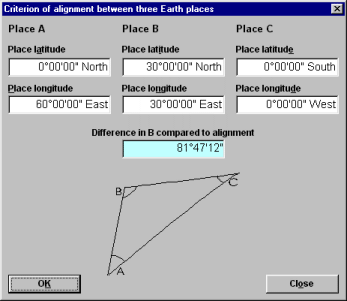
In the corresponding window, enter the coordinates (latitude and
longitude) for each place, before validating.
Various Time or Space
conversions
Several conversions are available from the
"Conversions" submenu from the "Space-time" menu:
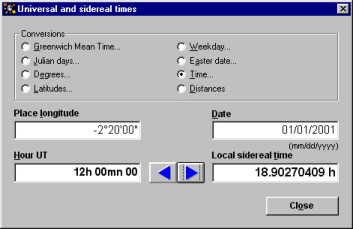
Greenwich sidereal time at midnight
calculation
- The Greenwich Sidereal Time at midnight (0h TU) is calculated from
"Greenwich time" option.
- In the corresponding window, enter the date for which you want to
know the Greenwich Sidereal Time at midnight, before validating.
Find the week day name of
a date
- The week day name of a given date is calculated from "Week
day" option.
- In the corresponding window, enter the date the weekday name of
which you want to know, before validating.
Find Easter date
- The (Catholic) Easter date for a given year is calculated from
"Easter date" option.
- In the corresponding window, enter the year the Easter date of
which you want to know, before validating.
Julian days and
Gregorian dates
- The conversion between a Gregorian calendar date and the
corresponding Julian day is done from "Julian days" option.
- In the corresponding window,
- either enter the Julian day before pressing the "Enter"
or "Carriage return" key to calculate the equivalent Gregorian date,
- or enter the Gregorian day before pressing the "Enter"
or "Carriage return" key to calculate the equivalent Julian day.
Universal and local
sidereal times
- The conversion between a universal time hour and the equivalent
local sidereal time hour is done from "Time" option.
- In the corresponding window, enter the considered date and the
earth location, then:
- either enter the UT hour before pressing the "Enter" or
"Carriage return" key to calculate the equivalent local sidereal time hour,
- or enter the local sidereal time hour before pressing the
"Enter" or "Carriage return" key to calculate the equivalent UT hour.
Astronomical and
geographical latitudes
- The conversion between the astronomical latitude of a considered
earth location and the geographical one is done from "Latitudes" option.
- In the corresponding window, enter the altitude of the earth
location, then:
- either enter the astronomical latitude before pressing the
"Enter" or "Carriage return" key to calculate the equivalent
geographical one,
- or enter the geographical latitude before pressing the
"Enter" or "Carriage return" key to calculate the equivalent
astronomical one.
Decimal and sexagesimal
degrees
- The conversion between a number of degrees in decimal form and the
same in sexagesimal form is done from "degrees" option.
- In the corresponding window,
- either enter the number of decimal degrees before pressing the
"Enter" or "Carriage return" key to calculate the equivalent number of
sexagesimal degrees,
- or enter the number of sexagesimal degrees before pressing the
"Enter" or "Carriage return" key to calculate the equivalent number of
decimal degrees.
Distance units
The conversion between a number of degrees in decimal form and
the same in sexagesimal form is done from "degrees" option.
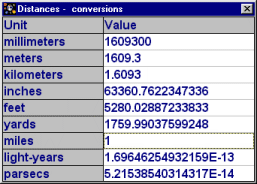
In the corresponding window, write a number in the text box for
the initial unit. As you are writing, the conversion into the other units are
automatically displayed.
Different calendars
The conversion between about twenty different calendars is done
from "Calendars" submenu of "Space-time" menu.
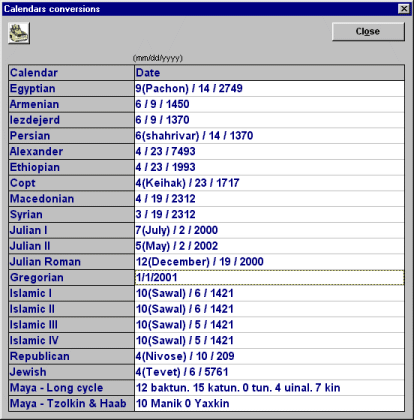
In the corresponding window, select the initial calendar and
enter the date expressed with this one. Separate the month, the day and the year using a
"/". The date in each other calendar is then automatically calculated and shown
as soon as you begin to write the year.
For the maya long cycle calendar, you must enter five different
numbers, separated with a "/". The date in the "Tzolkin & Haab"
maya calendar will then be given with the one for the other calendars, as soon as the
fifth number is written. But you can't write anything in the text box for the
"Tzolkin & Haab", since many dates, in other calendars, correspond to a
given Tzolkin & Haab one.







